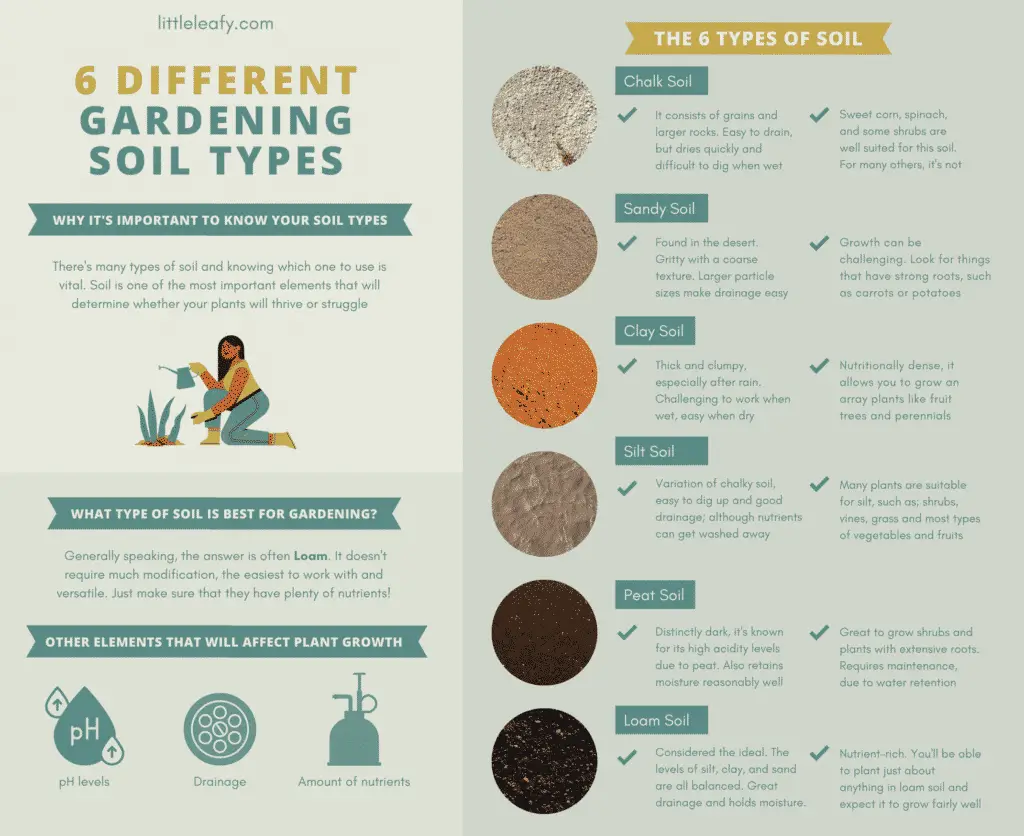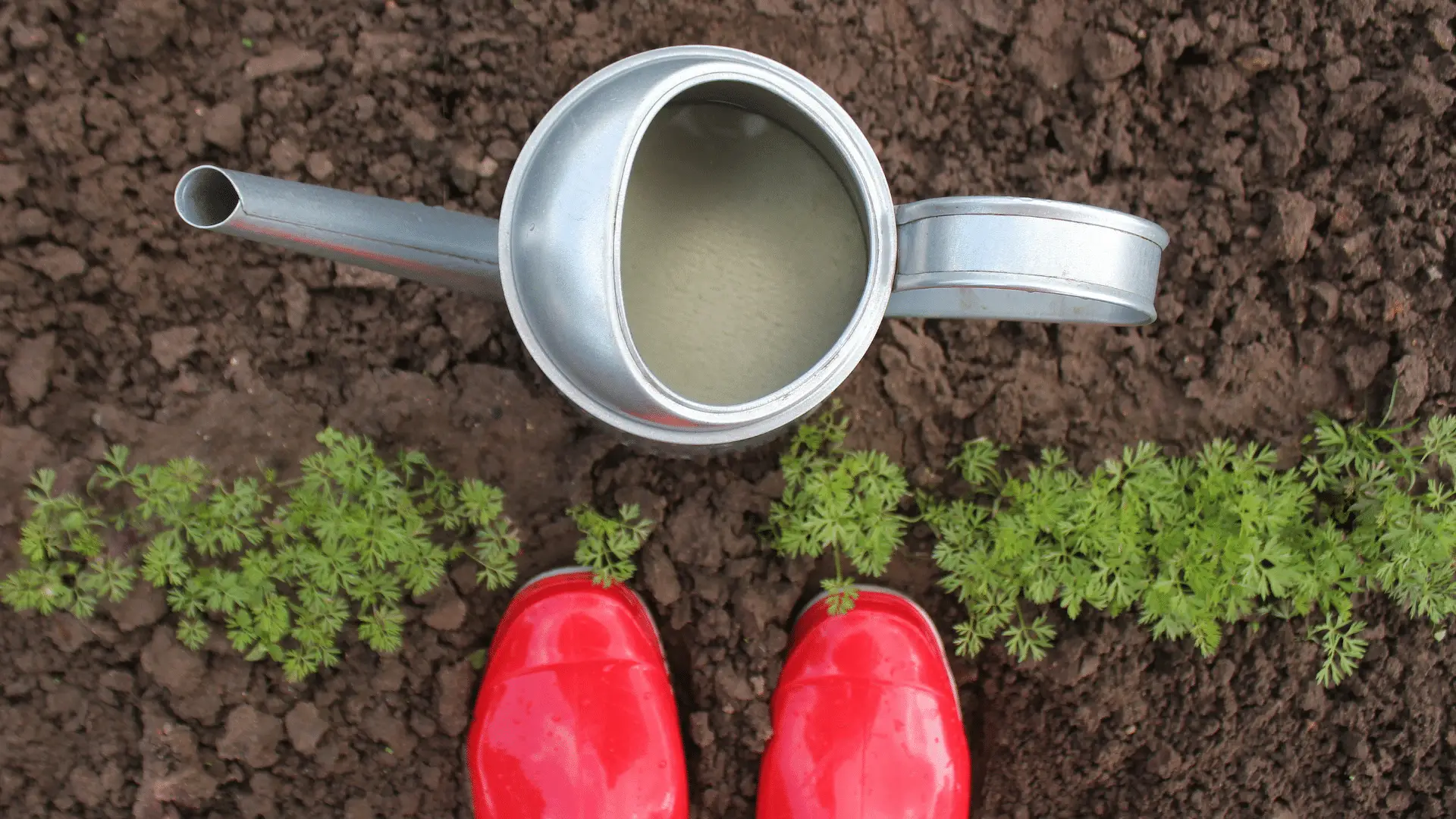Reading Time: 5 minutes 🍃
There are many types of soil. Knowing which type to have is vital. It’s often one of the most important elements determining whether your plants are thriving or struggling.
Being able to identify your soil type is essential for any gardener. Keep reading to learn more about the types of soils and how you should approach each.
Chalk
Let’s start by talking about chalk soil. This has a few key distinguishing features. The first is the size of the grains in the soil. Often, it will feature larger rocks.
It will be easy to drain and dry out very quickly. However, while it is wet, it will become sticky, making it difficult to dig. Because the soil doesn’t contain a lot of moisture, it will often come to be alkaline. This means that it will have a pH level that is over 7.5.
This type of soil can suit some types of plants. Things like sweet corn, spinach, and some shrubs (like photinias) can be a good match for this soil. However, for many others, it won’t be a good selection. It might result in stunted growth. Sometimes, the leaves might start to turn yellow because of the alkaline soil.
There are a few ways that you can correct these problems. These can include:
- Adding more acidic materials to lower the pH level. This includes things like compost and peat.
- Using humus. This might help your soil retain more moisture.
Sandy
Another soil that struggles to retain moisture is sandy. This is one of the easiest soil types to identify. It is the type found in the desert. It is known for being gritty with a coarse texture. The larger particle sizes make drainage easy. Not only does this make the soil dry, but it can also cause valuable nutrients to be washed away. This soil will also retain heat, getting very hot during summer.
Because of these harsh conditions, growing plants in a sandy environment will be challenging. But it can be done. You’ll need to look for things that have strong roots. For example, you might want to use vegetables like carrots or potatoes. It can also be a good choice for sun roses and some shrubs.
You can improve the soil by adding some compost or mulch. This will add nutrients and can be a good way of keeping moisture in the soil.
Clay
This is one of the most common soil types. It is characterized by small soil particles. As a result, it will often be thick, clumping together. This is especially common after rain. Because of this, it can be a challenge to work with it. As you can imagine, this limits drainage, so the soil retains a lot of moisture. However, it will be pretty easy to work with when the soil is dry.
This soil is known for being dense in nutrients, allowing you to grow a wide range of plants. It will suit things like fruit trees and perennials. It might also be a good idea for vegetables harvested during summer.
The best way to improve this type of soil is by increasing drainage. You might also want to add a layer of mulch during the winter months. This will stop the clay from freezing, making it exceedingly difficult to work with.
Silt
This is a variation of chalky soil. It will have very fine particles. This gives this soil type a lot of advantages. It will be easy for you to work with; you should dig it up easily. Plus, this soil tends to have reasonably good drainage.
Plenty of plants will be suitable for this type of soil. Some of the best options include:
- Shrubs
- Climbing vines
- Grass
- Trees, especially ones that need a lot of moisture
- Most types of vegetables and fruits
But no soil type is perfect, and this has a few downsides. Because it has such good drainage, there is a risk that valuable nutrients will be washed away. Also, the fine particles make it at risk of compaction.
Adding mulch is one of the best ways to improve this type of soil. This will give the soil plenty of nutrients. It’s also a simple way of retaining moisture.
Peat
This soil is known for its dark color, often appearing a rich brown. It is also known for being more acidic due to the high levels of peat. It will retain moisture reasonably well, which can make it feel spongy underfoot.
This is good soil for those who like to grow shrubs. It can also be a good option for plants that have extensive root systems.
On the downside, it will require a little more maintenance. Because it retains so much water, you might need to dig some drainage ditches. It can also be a good idea to use some fertilizers that help control the amount of acidity in the soil.
Loam
Finally, we have loam soil. This is often considered the ideal. The levels of silt, clay, and sand are all relatively easily balanced. This has good drainage but is still able to hold moisture. This makes it easy to work with, as it will always be pretty loose. Loamy soil is also known for containing plenty of nutrients. Plus, it doesn’t take much heat in spring for the soil to start getting warm, so you can start planting.
As a result of these factors, you will be able to plant just about anything in loam soil and expect it to grow fairly well. The only issue is that you might end up depleting nutrients from the soil. The best way to manage this is by adding some compost at the start of summer.
What Type of Soil is Best for Gardening?
Hopefully, by now, you have a better idea of which soil type you have. If not, there are a few simple tests that you can do . But this raises an important question. But which of the gardening soil types is best for gardening?
. But this raises an important question. But which of the gardening soil types is best for gardening?
As we mentioned, the answer is often loam. It’s the easiest to work with and will suit the most comprehensive array of plants. You also don’t need to do anything to modify the soil. All you need to do is make sure that they have plenty of nutrients.
There are a few other elements that will affect how well plants grow in your soil. These are:
- pH levels. If the soil is too alkaline or acidic it can start to cause serious problems. Often, the best option is to get soil with a pH of between 6.5 to 6.8
 . You can change the fertilizer mix to control pH.
. You can change the fertilizer mix to control pH. - Drainage. Often, you want to strike a balance in this area. You need enough drainage for the water to flow away. But too much, and the soil won’t be able to retain moisture.
- Amount of nutrients. You want to pick something that will be nutrient-rich.
It should be noted that these aspects aren’t fixed. For example, you can use thicker soil, like compost, on sandy soils to retain moisture and nutrients better. But you’ll still get the best results if you match your plants with the soil conditions.
Final Thoughts

Gardeners need to be aware of the type of soil they are dealing with. This will tell them what advantages they have and what challenges they will face. You’ll also be able to learn some of the most effective ways to improve your garden. Most importantly, you’ll know what type of plants will thrive in your local environment.


